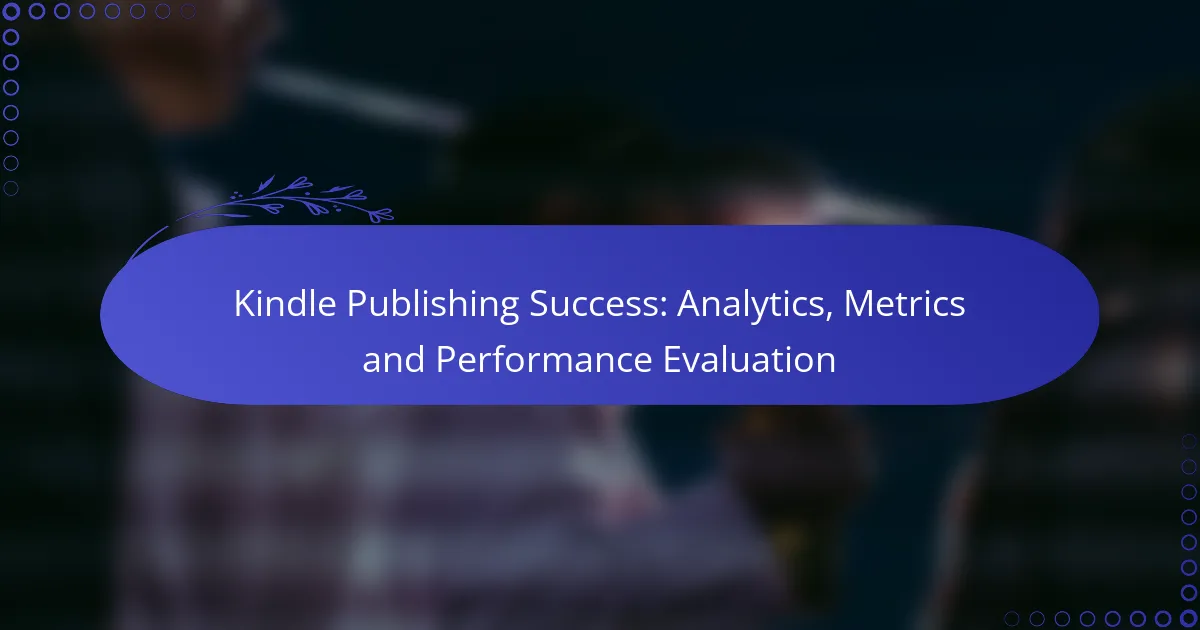In the competitive world of Kindle publishing, understanding analytics and key performance metrics is essential for success. By closely monitoring sales figures, reader engagement, and marketing effectiveness, authors can make informed decisions that enhance their visibility and profitability. This approach not only helps in evaluating current performance but also in refining strategies for future releases.

How to Analyze Kindle Publishing Performance?
To analyze Kindle publishing performance, focus on key metrics that reflect your book’s success, such as sales figures, reader engagement, and marketing effectiveness. Understanding these metrics helps you make informed decisions to improve your publishing strategy.
Key performance indicators (KPIs)
Key performance indicators (KPIs) for Kindle publishing include sales rank, number of downloads, and royalty earnings. Tracking these metrics over time can reveal trends in your book’s performance and help identify successful marketing strategies.
Other important KPIs are customer reviews and ratings, which provide insight into reader satisfaction. Aim for consistent improvement in these areas to enhance your book’s visibility and appeal.
Tools for performance analysis
Several tools can assist in analyzing Kindle publishing performance. Amazon’s KDP dashboard offers essential metrics, including sales data and royalty reports. This platform allows authors to monitor their performance in real-time.
Additionally, third-party tools like KDSpy and Publisher Rocket provide deeper insights into market trends and competitor analysis. These tools can help you identify profitable niches and optimize your marketing efforts.
Data sources for insights
Data sources for Kindle publishing insights include Amazon’s sales reports, customer feedback, and social media engagement metrics. Sales reports provide quantitative data, while reviews and ratings offer qualitative insights into reader preferences.
Social media platforms can also serve as valuable sources of data, revealing how readers interact with your content. Use these insights to refine your marketing strategies and better connect with your audience.
Interpreting analytics results
Interpreting analytics results involves analyzing trends and making data-driven decisions. Look for patterns in your sales data, such as spikes during promotions or seasonal fluctuations, to understand what drives sales.
Be cautious of outliers; a sudden increase in sales may not always indicate a successful strategy. Instead, consider the broader context and use multiple metrics to evaluate your performance comprehensively.

What Metrics Matter for Kindle Success?
Key metrics for Kindle publishing success include sales figures, read-through rates, customer reviews, and ranking positions. These metrics provide insights into a book’s performance and help authors make informed decisions to enhance their visibility and profitability.
Sales figures
Sales figures are a primary indicator of a book’s success on Kindle. They reflect the total number of copies sold, which directly impacts revenue. Tracking sales over time can reveal trends, such as seasonal fluctuations or the effectiveness of marketing strategies.
To evaluate your sales performance, consider comparing your figures against similar titles in your genre. This benchmarking can help you identify whether your sales are on par with industry standards or if adjustments are needed.
Read-through rates
Read-through rates measure how many readers continue to the next book in a series after finishing the first. A high read-through rate indicates that readers are engaged and interested in your work, which is crucial for series authors.
To improve read-through rates, ensure that your books are well-written and that the next book is readily available. Consider offering promotions or discounts on subsequent titles to encourage readers to continue with the series.
Customer reviews
Customer reviews are vital for building credibility and attracting new readers. Positive reviews can enhance your book’s visibility on Amazon, while negative reviews can deter potential buyers. Aim for a balanced number of reviews to establish trust.
Encourage readers to leave reviews by including a polite request at the end of your book. However, avoid incentivizing reviews, as this can violate Amazon’s policies and lead to penalties.
Ranking positions
Ranking positions indicate how well your book performs compared to others in the same category on Kindle. A higher ranking can lead to increased visibility and sales. Monitor your rankings regularly to gauge the impact of marketing efforts and reader engagement.
To improve your ranking, focus on optimizing your book’s metadata, including keywords and categories. Engaging in promotional activities, such as Kindle Countdown Deals or Free Book Promotions, can also boost your ranking temporarily.

How to Improve Kindle Book Visibility?
Improving Kindle book visibility involves optimizing your book’s presence on Amazon and using various marketing strategies. Focus on SEO, targeted advertising, and social media engagement to reach a wider audience.
SEO strategies for Kindle
SEO for Kindle books includes optimizing your book title, description, and keywords to enhance discoverability. Use relevant keywords that potential readers might search for, and ensure they appear naturally in your content.
Consider using tools like Kindlepreneur’s Keyword Tool to identify high-traffic keywords. Aim for a balance between popular terms and niche phrases to attract your target audience effectively.
Utilizing Amazon Ads
Amazon Ads can significantly boost your book’s visibility by placing it in front of interested readers. Start with Sponsored Products ads to promote your book directly in search results and on product pages.
Set a daily budget that aligns with your marketing goals, typically starting from $5 to $20 per day. Monitor your ad performance regularly and adjust bids or keywords based on what generates the best return on investment.
Leveraging social media
Social media platforms are powerful tools for promoting your Kindle book. Create engaging content related to your book’s themes, and share snippets or behind-the-scenes insights to attract followers.
Consider platforms like Facebook, Instagram, and TikTok, where you can connect with potential readers. Use targeted ads on these platforms to reach specific demographics that align with your book’s audience.

What Are Effective Marketing Strategies for Kindle Authors?
Effective marketing strategies for Kindle authors include targeted email campaigns, strategic book launches, and collaborations with influencers. These approaches can significantly enhance visibility and sales, helping authors reach their desired audience more efficiently.
Email marketing campaigns
Email marketing campaigns are a powerful tool for Kindle authors to engage with readers directly. By building a mailing list, authors can share updates, promotions, and exclusive content, fostering a loyal reader base.
To create an effective email campaign, consider segmenting your audience based on their interests and reading habits. This allows for personalized messaging that resonates more with recipients. Aim for a frequency of 1-2 emails per month to maintain engagement without overwhelming your subscribers.
Book launch strategies
Book launch strategies are critical for maximizing initial sales and visibility. A successful launch often involves pre-launch buzz, promotional pricing, and leveraging social media to create excitement.
Consider offering limited-time discounts or free promotions during the launch week. Engaging with readers through live events or virtual book signings can also enhance visibility. Aim for a coordinated effort that includes outreach to your mailing list and social media followers to generate momentum.
Collaborations with influencers
Collaborating with influencers can expand your reach significantly. Influencers with a following in your book’s genre can introduce your work to new audiences, increasing credibility and interest.
When seeking collaborations, look for influencers who align with your brand and have an engaged audience. Consider offering them free copies of your book in exchange for honest reviews or features on their platforms. This mutual benefit can lead to increased exposure and potential sales.

How to Evaluate Reader Engagement on Kindle?
To evaluate reader engagement on Kindle, focus on analyzing feedback, tracking relevant metrics, and gathering insights through surveys. These methods provide a comprehensive view of how readers interact with your content and highlight areas for improvement.
Analyzing reader feedback
Reader feedback is crucial for understanding engagement levels. Look for reviews and comments on your Kindle books, as they can reveal what readers appreciate or dislike. Pay attention to recurring themes in feedback to identify strengths and weaknesses in your writing.
Consider using platforms like Goodreads or Amazon’s review section to gather insights. Analyzing star ratings can also help you gauge overall reader satisfaction, with higher ratings typically indicating better engagement.
Tracking engagement metrics
Engagement metrics provide quantitative data on how readers interact with your Kindle books. Key metrics include page reads, reading time, and completion rates. For instance, a high completion rate suggests that readers are finding your content compelling enough to finish.
Utilize Kindle Direct Publishing (KDP) reports to access these metrics. Regularly monitoring these numbers can help you identify trends over time, allowing you to make informed decisions about future projects or marketing strategies.
Using surveys for insights
Surveys can offer direct insights into reader preferences and experiences. Consider creating short, targeted surveys to ask readers specific questions about your book’s content, pacing, and overall enjoyment. Tools like Google Forms or SurveyMonkey can facilitate this process.
When designing surveys, keep them concise to encourage participation. Offering a small incentive, such as a discount on future books, can also increase response rates. Analyzing survey results can provide actionable feedback to enhance future writing projects.

What Tools Can Help with Kindle Publishing Analytics?
Several tools can enhance your Kindle publishing analytics, providing insights into sales performance, reader engagement, and marketing effectiveness. Utilizing these tools can help you make data-driven decisions to optimize your publishing strategy.
Amazon KDP Reports
Amazon’s Kindle Direct Publishing (KDP) Reports provide essential metrics such as sales data, royalties earned, and page reads for Kindle Unlimited titles. These reports are updated daily, allowing authors to track performance over time and identify trends.
To access KDP Reports, log into your KDP account and navigate to the Reports section. Look for key indicators like daily sales, monthly earnings, and customer reviews to gauge your book’s performance.
Google Analytics
Google Analytics can be integrated into your author website to monitor traffic sources, user behavior, and conversion rates. This tool helps you understand how visitors interact with your site and which marketing strategies drive book sales.
Set up goals in Google Analytics to track specific actions, such as newsletter sign-ups or purchases. Regularly review your analytics to refine your marketing efforts and improve your website’s performance.
Book Report
Book Report is a user-friendly tool that aggregates data from your KDP account and presents it in an easy-to-read format. It offers insights into sales trends, earnings projections, and performance comparisons across different titles.
By using Book Report, you can quickly visualize your sales data and make informed decisions about pricing, promotions, and future projects. This tool is particularly useful for authors with multiple titles, as it allows for straightforward performance tracking.
Kindle Spy
Kindle Spy is a market research tool that provides insights into bestselling books in your genre. It helps authors analyze competitors’ sales ranks, pricing strategies, and keywords, which can inform your own publishing decisions.
Utilize Kindle Spy to identify trends and gaps in the market. By understanding what works for other successful authors, you can tailor your content and marketing strategies to better meet reader demands.
Social Media Analytics
Social media platforms like Facebook, Twitter, and Instagram offer built-in analytics tools that track engagement metrics such as likes, shares, and comments. These insights help you understand which content resonates with your audience and drives traffic to your books.
Regularly review your social media analytics to refine your content strategy. Focus on posts that generate the most engagement and consider using paid promotions to reach a wider audience.
